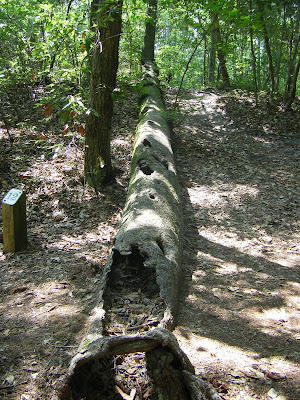This tree is blooming now all across the area, and is probably about 1-2 weeks earlier than normal. I am fond of this plant because it is very hardy for us; blooms when few other trees are blooming - and it is lilac-blue. I know of no other tree that blooms this color in this climate. There are pale pink and white cultivars available, but why would you want them when you can have blue? Vitex can take a lot of heat and sun, can withstand coastal conditions and whistles through any drought. However, it does not like to have prolonged wet feet. It is hardy from the warmer parts of zone 6 into zone 9, and in the colder parts of its limits, it can be treated as a cut back shrub, similar to a Buddleia. In the mid range it behaves like a multi-stemmed shrub, and here it makes an attractive small tree reaching about 15' tall. If you spend the time to do a little lower limb pruning, its attractive blocky bark is revealed. The blooms last about a month attracting lots of bees and the occasional hummingbird. If you have the inclination and a sturdy ladder, deadheading makes them bloom again in early fall. The leaves are reminiscent in appearance to marijuana, and both the foliage and the seeds have a strong medicinal smell. There is no appreciable fall color.
Vitex is native to southwestern Europe and western Asia, where it has a long storied history. It was mistakenly believed to be an ANAphrodisiac quelling the sexual desires of people who ingested it or slept on beds of it. It was thought to keep the thoughts of temple maidens pure while they tended to their duties, and kept the hands of monks out from under their robes and the robes of others (hence the name Chaste Tree). Coincidentally, it does have an effect on the body's hormones and has been proven to ease PMS and promote lactation. If you do a little on-line research, you will discover scads of information on Vitex's medical/herbal uses. Author Stephen Foster has an interesting article
here about Vitex's medicinal history.


This shot below may seem a little hazy, and that was because it was an extremely smoky day with the fires from the swamp still churning away. Even though at this point, the fires are 90% contained, they are mainly peat fires and produce a particularly acrid smoke.


The bees can be so thick on Vitex, that you get the illusion that the whole tree is subtly moving.


I like to see Vitex planted in groups and limbed up, looking like a grove of small gnarly trees. This makes a great place to plant shade tolerant perennials. If you ever visit
Busch Gardens in Williamsburg, look next to the Big Bad Wolf and you will see this done very nicely.
One last thing; try to avoid planting
Vitex rontundifolia or Beach Vitex. It has become something that needs to be eradicated in the coastal dune ecosystem. It is just as pretty and just as tough, but it is choking out natives that do a much better job of dune stablization.
 The lighthouse was the first public works project that the newly formed United States chose to fund. George Washington took an avid interest in the construction of the light and it was completed in 1791. It was built on the top of a tall hill, probably the remnants of an old sand dune.
The lighthouse was the first public works project that the newly formed United States chose to fund. George Washington took an avid interest in the construction of the light and it was completed in 1791. It was built on the top of a tall hill, probably the remnants of an old sand dune.

 From the top you get a good view of the Chesapeake, the Atlantic and Fort Story. There were many dolphins in the water feeding, playing and doing whatever it is dolphins do. You also get a good view of the "new" lighthouse.
From the top you get a good view of the Chesapeake, the Atlantic and Fort Story. There were many dolphins in the water feeding, playing and doing whatever it is dolphins do. You also get a good view of the "new" lighthouse.
 This is the underside of the dome.
This is the underside of the dome. I wondered why they kept these bags of Quickcrete door near the stairs. Was it for emergencies?
I wondered why they kept these bags of Quickcrete door near the stairs. Was it for emergencies? The base of the tower is made of soft Aquia sandstone, and originally it was below the soil line at the top of the hill the tower rests on. With wind erosion the base is now exposed 7' below its original level.
The base of the tower is made of soft Aquia sandstone, and originally it was below the soil line at the top of the hill the tower rests on. With wind erosion the base is now exposed 7' below its original level. The "new" lighthouse began operation in 1881, and is still in use today. The old light was purchased by the Association for the Preservation of Virginia Antiquities (APVA) and is one of their 32 owned or maintained properties.
The "new" lighthouse began operation in 1881, and is still in use today. The old light was purchased by the Association for the Preservation of Virginia Antiquities (APVA) and is one of their 32 owned or maintained properties. The fence outside of the lighthouse grounds is adorned with black ribbons, and on them is a hand written list of all of the soldiers who have been killed in the current Iraq war. The memorial is very organic and citizen driven, and stands in marked contrast to the officialness and sterility of the base. The ribbons were already fading and tattered, and I feel that many people's awareness of this ill-conceived war is in the same condition as the ribbons.
The fence outside of the lighthouse grounds is adorned with black ribbons, and on them is a hand written list of all of the soldiers who have been killed in the current Iraq war. The memorial is very organic and citizen driven, and stands in marked contrast to the officialness and sterility of the base. The ribbons were already fading and tattered, and I feel that many people's awareness of this ill-conceived war is in the same condition as the ribbons. 













































